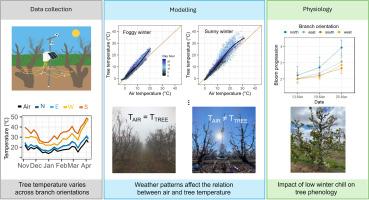当前位置:
X-MOL 学术
›
Agric. For. Meteorol.
›
论文详情
Our official English website, www.x-mol.net, welcomes your
feedback! (Note: you will need to create a separate account there.)
The TreeChill model: A new framework for predicting the impact of erratic winter weather on trees
Agricultural and Forest Meteorology ( IF 5.6 ) Pub Date : 2025-05-27 , DOI: 10.1016/j.agrformet.2025.110647
Paula Guzmán-Delgado, Emily Santos, Mohammad Yaghmour, Emilio A. Laca, Kari Arnold, Amrit Pokhrel, Kosana Suvočarev, Mohamed Nouri, Katherine Jarvis-Shean, Louise Ferguson, Aileen Salas, Daniel Ruiz, Giulia Marino
Agricultural and Forest Meteorology ( IF 5.6 ) Pub Date : 2025-05-27 , DOI: 10.1016/j.agrformet.2025.110647
Paula Guzmán-Delgado, Emily Santos, Mohammad Yaghmour, Emilio A. Laca, Kari Arnold, Amrit Pokhrel, Kosana Suvočarev, Mohamed Nouri, Katherine Jarvis-Shean, Louise Ferguson, Aileen Salas, Daniel Ruiz, Giulia Marino

|
Perennial plants rely on exposure to low winter temperatures to break dormancy, aligning reproductive timing with local weather conditions. Current chill accumulation models quantify this exposure using only air temperature as input, leading to reduced accuracy as climate becomes more variable and unpredictable. This study introduces a novel framework that replaces air temperature with tree temperature as a continuous functional parameter to improve the reliability of chill accumulation calculations. Over three winters, we measured tree temperature and collected weather data in sweet cherry orchards in distinct climate areas. Tree temperature exceeded air temperature, particularly on sunny days, leading to a 15 % reduction in chill accumulation. We developed the TreeChill model, which predicts tree temperature using publicly available weather data with high precision. The model has a coefficient of determination of 0.930 and a standard deviation of residuals of 2.02 °C. The difference in chill accumulation calculated using predicted versus measured tree temperature was only 0.4 chill portions. Tree temperature provided more accurate insights into dormancy-related processes than air temperature. Variations in bloom progression within sweet cherry tree canopies corresponded to differences in tree temperature, and bloom timing was precipitated by prolonged winter chill exposure at the branch level, followed by localized short-term heat exposure. This study integrates macro- and micro-climatic data and plant physiological information and can be used in different climate-related prediction models to enhance their precision. The model will make tree temperature readily available to researchers and stakeholders, facilitating the development of climate change mitigation strategies in agricultural, natural and urban systems.
中文翻译:

TreeChill 模型:预测不稳定的冬季天气对树木影响的新框架
多年生植物依靠暴露在冬季低温下来打破休眠,使繁殖时间与当地的天气条件保持一致。目前的寒冷累积模型仅使用空气温度作为输入来量化这种暴露,随着气候变得更加多变和不可预测,准确性会降低。本研究引入了一种新的框架,以树木温度代替空气温度作为连续函数参数,以提高寒冷累积计算的可靠性。在三个冬天里,我们测量了树木的温度,并收集了不同气候区甜樱桃园的天气数据。树木温度超过空气温度,尤其是在阳光明媚的日子里,导致寒冷积累减少了 15%。我们开发了 TreeChill 模型,该模型使用公开可用的天气数据高精度地预测树木温度。该模型的决定系数为 0.930,残差的标准差为 2.02 °C。 使用预测与测量的树木温度计算的寒冷积累的差异仅为 0.4 个寒冷部分。树木温度比空气温度更准确地了解休眠相关过程。甜樱桃树冠内开花进程的变化与树木温度的差异相对应,开花时间是由树枝水平长时间的冬季寒冷暴露,然后是局部的短期高温暴露而促成的。本研究整合了宏观和微观气候数据以及植物生理信息,可用于不同的气候相关预测模型以提高其精度。 该模型将使研究人员和利益相关者随时获得树木温度,从而促进农业、自然和城市系统气候变化缓解策略的制定。
更新日期:2025-05-27
中文翻译:

TreeChill 模型:预测不稳定的冬季天气对树木影响的新框架
多年生植物依靠暴露在冬季低温下来打破休眠,使繁殖时间与当地的天气条件保持一致。目前的寒冷累积模型仅使用空气温度作为输入来量化这种暴露,随着气候变得更加多变和不可预测,准确性会降低。本研究引入了一种新的框架,以树木温度代替空气温度作为连续函数参数,以提高寒冷累积计算的可靠性。在三个冬天里,我们测量了树木的温度,并收集了不同气候区甜樱桃园的天气数据。树木温度超过空气温度,尤其是在阳光明媚的日子里,导致寒冷积累减少了 15%。我们开发了 TreeChill 模型,该模型使用公开可用的天气数据高精度地预测树木温度。该模型的决定系数为 0.930,残差的标准差为 2.02 °C。 使用预测与测量的树木温度计算的寒冷积累的差异仅为 0.4 个寒冷部分。树木温度比空气温度更准确地了解休眠相关过程。甜樱桃树冠内开花进程的变化与树木温度的差异相对应,开花时间是由树枝水平长时间的冬季寒冷暴露,然后是局部的短期高温暴露而促成的。本研究整合了宏观和微观气候数据以及植物生理信息,可用于不同的气候相关预测模型以提高其精度。 该模型将使研究人员和利益相关者随时获得树木温度,从而促进农业、自然和城市系统气候变化缓解策略的制定。


















































 京公网安备 11010802027423号
京公网安备 11010802027423号